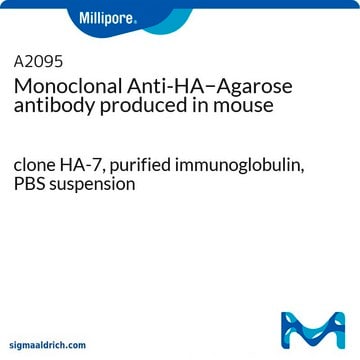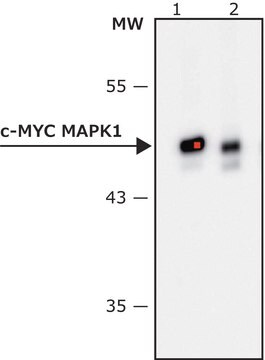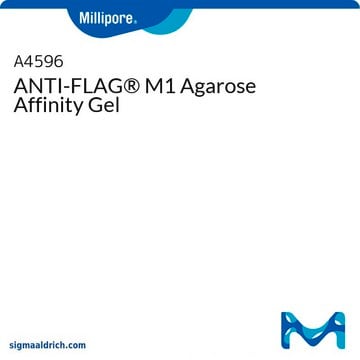16-219
Anti-Myc Tag Antibody, clone 4A6, agarose conjugate
clone 4A6, Upstate®, from mouse
Sign Into View Organizational & Contract Pricing
All Photos(1)
About This Item
UNSPSC Code:
12352203
eCl@ss:
32160702
NACRES:
NA.43
Recommended Products
biological source
mouse
Quality Level
antibody form
purified immunoglobulin
antibody product type
primary antibodies
clone
4A6, monoclonal
species reactivity
human
manufacturer/tradename
Upstate®
technique(s)
immunoprecipitation (IP): suitable
NCBI accession no.
UniProt accession no.
shipped in
wet ice
target post-translational modification
unmodified
Gene Information
human ... MYC(4609)
General description
Epitope tags are short peptide sequences that are easily recognized by tag-specific antibodies. Due to their small size, epitope tags do not affect the tagged protein’s biochemical properties. Most often sequences encoding the epitope tag are included with target DNA at the time of cloning to produce fusion proteins containing the epitope tag sequence. This allows anti-epitope tag antibodies to serve as universal detection reagents for any tag containing protein produced by recombinant means. This means that anti-epitope tag antibodies are a useful alternative to generating specific antibodies to identify, immunoprecipitate or immunoaffinity purify a recombinant protein. The anti-epitope tag antibody is usually functional in a variety of antibody-dependent experimental procedures. Expression vectors producing epitope tag fusion proteins are available for a variety of host expression systems including bacteria, yeast, insect and mammalian cells.
Specificity
Reactivity with other species has not been confirmed.
Immunogen
KLH-conjugated, synthetic peptide corresponding to amino acids 410-420 (MEQKLISEEDL) of human Myc.
Application
Anti-Myc Tag Antibody, clone 4A6, agarose conjugate detects level of Myc Tag & has been published & validated for use in IP.
Immunoaffinity Purification:
A previous lot was used to purify Myc-tagged proteins. Elute with 100 mM tetraethyl ammonium (TEA), pH 11.5.
A previous lot was used to purify Myc-tagged proteins. Elute with 100 mM tetraethyl ammonium (TEA), pH 11.5.
Features and Benefits
Format: Gel Immobilized
Quality
Routinely evaluated by immunoprecipitation of Myc-tagged Akt/PKB from a COS transfected cell lysate, subsequent detection using anti-Myc Tag (05-724).
Immunoprecipitation Analysis:
4 μg of anti-Myc Tag, clone 4A6, agarose conjugate immunoprecipitated Myc-tagged Akt/PKB from 250 μg of a COS transfected cell lysate, which was then detected by immunoblot analysis, using 0.5 μg/mL of anti-Myc Tag, clone 4A6 (Catalog # 05-724).
Immunoprecipitation Analysis:
4 μg of anti-Myc Tag, clone 4A6, agarose conjugate immunoprecipitated Myc-tagged Akt/PKB from 250 μg of a COS transfected cell lysate, which was then detected by immunoblot analysis, using 0.5 μg/mL of anti-Myc Tag, clone 4A6 (Catalog # 05-724).
Target description
Varies
Physical form
Purified mouse monoclonal IgG1 covalently coupled to protein G agarose beads and provided as a 50% slurry in buffer containing PBS, pH 7.4, and 0.05% sodium azide. Liquid suspension.
Storage and Stability
Stable for 1 year at 2-8ºC from date of receipt. Aliquot to avoid repeated freezing and thawing. For maximum recovery of product, centrifuge the original vial after thawing and prior to removing the cap.
Analysis Note
Control
Cells transfected with Myc-tagged fusion vector.
Cells transfected with Myc-tagged fusion vector.
Other Notes
Concentration: Please refer to the Certificate of Analysis for the lot-specific concentration.
Legal Information
UPSTATE is a registered trademark of Merck KGaA, Darmstadt, Germany
Not finding the right product?
Try our Product Selector Tool.
Storage Class Code
10 - Combustible liquids
WGK
WGK 2
Certificates of Analysis (COA)
Search for Certificates of Analysis (COA) by entering the products Lot/Batch Number. Lot and Batch Numbers can be found on a product’s label following the words ‘Lot’ or ‘Batch’.
Already Own This Product?
Find documentation for the products that you have recently purchased in the Document Library.
Customers Also Viewed
Dong-Lei Yang et al.
Cell discovery, 4, 55-55 (2018-10-23)
DNA methylation is a conserved epigenetic mark that is critical for many biological processes in plants and mammals. In Arabidopsis, the antagonistic activities of RNA-directed DNA methylation (RdDM) and ROS1-dependent active DNA demethylation are key for the dynamic regulation of
Mutagenesis and analysis of genetic mutations in the GC-rich KISS1 receptor sequence identified in humans with reproductive disorders.
Luciana Madeira da Silva,Lauren Vandepas,Suzy D C Bianco
Journal of Visualized Experiments null
X Fu et al.
Journal of dental research, 96(12), 1451-1458 (2017-07-22)
Previous studies have identified the odd-skipped related 2 (Osr2) transcription factor as a key intrinsic regulator of palatal shelf growth and morphogenesis. However, little is known about the molecular program acting downstream of Osr2 in the regulation of palatogenesis. In
Tadashi Okubo et al.
Development (Cambridge, England), 138(2), 339-348 (2010-12-24)
The pharyngeal apparatus is a transient structure that gives rise to the thymus and the parathyroid glands and also contributes to the development of arteries and the cardiac outflow tract. A typical developmental disorder of the pharyngeal apparatus is the
Byoung Il Je et al.
eLife, 7 (2018-03-16)
Meristems contain groups of indeterminate stem cells, which are maintained by a feedback loop between CLAVATA (CLV) and WUSCHEL (WUS) signaling. CLV signaling involves the secretion of the CLV3 peptide and its perception by a number of Leucine-Rich-Repeat (LRR) receptors
Our team of scientists has experience in all areas of research including Life Science, Material Science, Chemical Synthesis, Chromatography, Analytical and many others.
Contact Technical Service















